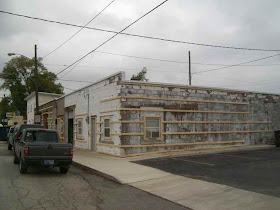This post completes the
tour of stained glass windows at St. Mary's Church in Beaverville, IL.
The seventh window in the series shows the Death of St. Joseph. I was not quite sure what this was until I read the guide. There is no Biblical source for this. The last mention of Joseph in the Gospels is in the story of the young Jesus in the temple. Since he is not mentioned later, the assumption is that he died before the public ministry of Christ.

The next window is Christ blessing the Children. (Mark 9:36-7, also in Luke and Matthew). Putting this scene in the series strikes me as odd because Mary is not mentioned in the gospels accounts. (Other things that strike me as odd in the selection of scenes: there is no window for the
flight into Egypt, and there is no window for the
wedding feast at Cana.) But since the nuns were staffing a school, they probably wanted a scene with children in it.

There are two very large windows on the sides. One is of Christ carrying the cross, the part of the
crucifixion narrative.

The deposition from the cross is the topic of many artists, none more famous than
Michelangelo.

The other large window shows the
Assumption of Mary.

Window 12 shows Mary
Queen of Heaven holding the Christ child. Below are two souls in
purgatory. An angel is drawing one up into heaven, while another angel is telling the second he has to wait a bit longer.
Window 13 shows Mary with
St. Dominic receiving the
rosary. Dominic was the founder of the Dominican order, which remains one of the largest orders of priests and nuns in the Catholic Church. The most famous Dominican was St.
Thomas Aquinas.

The final window in the series is of the apparition of Mary to Bernadette at
Lourdes. This scene is not surprising because Lourdes is in France, Beaverville was populated by people of French descent, and the nuns staffing the school were from an order with roots in France. Also, the
grotto on the grounds was meant to be a recreation of the grotto at Lourdes.

Here is a view of the church from the entrance looking toward the altar. The color scheme is appropriate for a church named St. Mary's. You can see at least bits of the seven stained-glass windows behind the altar. I did not get usable photos of these. The are windows showing Bishop Just and St. Viator, St. Monica and St. Augustine, the Last Supper, Joseph of Arimathea takes down Jesus, St. Anthony of Padua, and a guardian angel watching over a boy.
The small circular windows around the base of the dome are plain and let in light.

These windows were restored between the summer of 2001 and the summer of 2004.
 The sale begins Friday when the doors open at 9:00. Fill a grocery bag for $2. On Saturday Oct 3 from 9 am to noon fill any size bag or box for $1.
The sale begins Friday when the doors open at 9:00. Fill a grocery bag for $2. On Saturday Oct 3 from 9 am to noon fill any size bag or box for $1.





















































